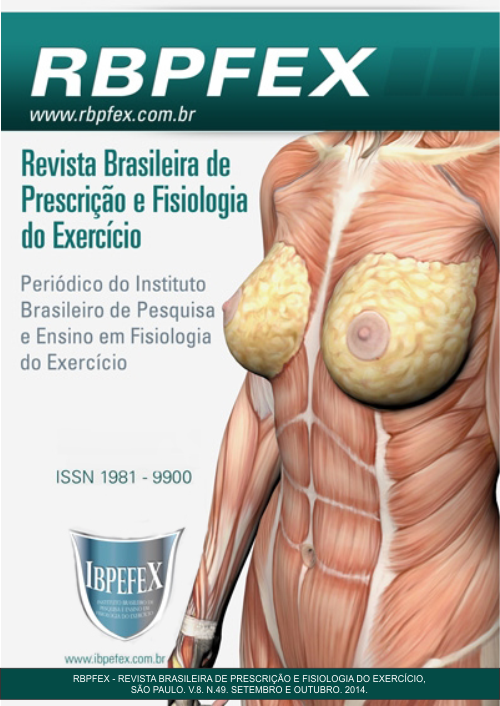Effect of 12 sessions of resistive training in body composition: a case study
Abstract
Introduction:Overweight predisposes the body to a number of diseases such as heart failure, stroke and cerebral hemorrhage, and coronary thrombosis. The exercise prescription for weight loss was restricted to aerobic exercise for these to have a greater caloric expenditure during exercise when compared to resistance training. In the mid-80s, the scientific community recognized the potential value of weight training on functional capacity and other factors related to health, basal metabolism, and weight control. Aims:This study aims to analyze the effect of 12 sessions of resistance training of moderate intensity (60% 1RM) performed 3 times a week in body composition of an individual female, adult and sedentary. Materials andmethods:For the research was selected a woman of 56 years and sedentary that underwent 12 sessions of strength training with 60% of 1 RM. Results:It was observed that the reduction in total body mass and fat mass and increasing lean body mass. Discussion:Studies show changes in body composition in subjects undergoing strength training with intensity and relatively high volume. The same is not observed in individuals undergoing training protocols intensity and short volume. Conclusion:Although this study show a trend of change in body composition with only twelve sessions of strength training more studies are needed to examine the effectiveness of a short training on body composition.
References
-Arruda, D.P.; Assumpção, C.O.; Urtado, C.B.; Dorta, L.N.O.; Rosa, M.R.R.; Zabaglia, R.; Souza, T.M.F. Relação entre treinamento de força e redução do peso corporal. Revista Brasileira de Prescrição e Fisiologia do Exercício. São Paulo. Vol. 4. Núm. 24. p. 605-609. 2010.
-Baechle, T.R.; Earle, R.W. Essential of Strength Training and Conditioning. Champaign.Human Kinetics.2000.
-Domingues Filho, L.A -Obesidade & atividade física. Fontoura. 2000.
-Feigenbaum, M.S.; Pollock, M.L. Prescription of resistance training for health and disease. Medicine Science Sports Exercises. Vol. 31. Núm. 1. p. 38-45. 1999.
-Ferreira, S.; Tinoco, A.L.A.; Panato, E.; Viana, N.L. Aspectos etiológicos e o papel do exercício físico na prevenção e controle da obesidade. Revista de educação Física. Núm. 133. 2006.
-Fett, C.A.; Fett, W.C.R.; Oyama, S.R.; Marchini, J.S. Composição corporal e somatótipo de mulheres com sobrepeso e obesas pré e pós-treinamento em circuito ou caminhada. Rev. Bras.Med. Esp. Vol. 12. Núm.1. 2006.
-Pereira, L.O.; Francischi, R.P.; Lancha Junior, A.H. Obesidade: Hábitos Nutricionais, Sedentarismo e Resistência à Insulina. Arquivo. Brasileiro. Endocrinologia. Metabolismo. Vol. 47. Núm. 2. 2003.
-Moreno, J.R.; Sousa, M.V.; Pacheco, M.E.; Silva, L.G.M.; Campbell C.S.G.; Simões, H.G. Treinamento resistido de oito semanas melhora a aptidão física, mas não altera o perfil lipídico de indivíduos hipercolesterolêmicos. Efdeportes. Rev. Dig. Num. 81. 2005.
-Peraça, D.G.; Fagundes, L.C.L.; Liberali, R. A eficácia do treinamento de força na diminuição do percentual de gordura corporal de homens e mulheres. Revista Brasileira de Prescrição e Fisiologia do Exercício. São Paulo. Vol. 2. Núm.11. p. 490-497. 2008.
-Prabhakaran, B.; Dowling, E.A.; Branch, J.D.; Swain, D.P.; Leutholtz, B.C. Effect of 14 weeks of resistance training on lipid profile and body fat percentage in premenopausal women. In: Br F Sports Med. Vol. 33. p. 190-195. 1999.
-Santos, D.A.; Liberali, R. Efeito de 12 semanas de treinamento com pesos na força e composição corporal de idosas. Revista Brasileira de Prescrição e Fisiologia do Exercício. São Paulo. Vol. 2. Núm. 10. p. 439-447. 2008.
-Schuenke, M.D.; Mikat, R.P.; Mcbride, J.M. Effect of an acute period ofresistance exerciseon excess post-exercise oxygen consumption: implications for body mass management. European Journal of Applied Physiology. Vol. 86. p. 411-417. 2002.
-Schwingshandl, A.J.; Sudi, K.; Eibl, B.; Wallner, S.; Borkenstein, M. Effect of anindividualized training program during weight reduction on body composition: a randomized trial. Archivesof Disease in Childhood. Vol. 81. p. 426-428. 1999.
Authors who publish in this journal agree to the following terms:
- Authors retain the copyright and grant the journal the right of first publication, with work simultaneously licensed under the Creative Commons Attribution License BY-NC which allows the sharing of the work with acknowledgment of the authorship of the work and initial publication in this journal.
- Authors are authorized to enter into additional contracts separately for non-exclusive distribution of the version of the work published in this journal (eg, publishing in institutional repository or book chapter), with acknowledgment of authorship and initial publication in this journal.
- Authors are allowed and encouraged to post and distribute their work online (eg, in institutional repositories or on their personal page) at any point before or during the editorial process, as this can bring about productive change as well as increase impact and impact. citation of published work (See The Effect of Free Access).






